Angana Borah
NLP for Social Good: A Survey of Challenges, Opportunities, and Responsible Deployment
May 28, 2025Abstract:Recent advancements in large language models (LLMs) have unlocked unprecedented possibilities across a range of applications. However, as a community, we believe that the field of Natural Language Processing (NLP) has a growing need to approach deployment with greater intentionality and responsibility. In alignment with the broader vision of AI for Social Good (Toma\v{s}ev et al., 2020), this paper examines the role of NLP in addressing pressing societal challenges. Through a cross-disciplinary analysis of social goals and emerging risks, we highlight promising research directions and outline challenges that must be addressed to ensure responsible and equitable progress in NLP4SG research.
Mind the (Belief) Gap: Group Identity in the World of LLMs
Mar 03, 2025



Abstract:Social biases and belief-driven behaviors can significantly impact Large Language Models (LLMs) decisions on several tasks. As LLMs are increasingly used in multi-agent systems for societal simulations, their ability to model fundamental group psychological characteristics remains critical yet under-explored. In this study, we present a multi-agent framework that simulates belief congruence, a classical group psychology theory that plays a crucial role in shaping societal interactions and preferences. Our findings reveal that LLMs exhibit amplified belief congruence compared to humans, across diverse contexts. We further investigate the implications of this behavior on two downstream tasks: (1) misinformation dissemination and (2) LLM learning, finding that belief congruence in LLMs increases misinformation dissemination and impedes learning. To mitigate these negative impacts, we propose strategies inspired by: (1) contact hypothesis, (2) accuracy nudges, and (3) global citizenship framework. Our results show that the best strategies reduce misinformation dissemination by up to 37% and enhance learning by 11%. Bridging social psychology and AI, our work provides insights to navigate real-world interactions using LLMs while addressing belief-driven biases.
Persuasion at Play: Understanding Misinformation Dynamics in Demographic-Aware Human-LLM Interactions
Mar 03, 2025



Abstract:Existing challenges in misinformation exposure and susceptibility vary across demographic groups, as some populations are more vulnerable to misinformation than others. Large language models (LLMs) introduce new dimensions to these challenges through their ability to generate persuasive content at scale and reinforcing existing biases. This study investigates the bidirectional persuasion dynamics between LLMs and humans when exposed to misinformative content. We analyze human-to-LLM influence using human-stance datasets and assess LLM-to-human influence by generating LLM-based persuasive arguments. Additionally, we use a multi-agent LLM framework to analyze the spread of misinformation under persuasion among demographic-oriented LLM agents. Our findings show that demographic factors influence susceptibility to misinformation in LLMs, closely reflecting the demographic-based patterns seen in human susceptibility. We also find that, similar to human demographic groups, multi-agent LLMs exhibit echo chamber behavior. This research explores the interplay between humans and LLMs, highlighting demographic differences in the context of misinformation and offering insights for future interventions.
The Power of Many: Multi-Agent Multimodal Models for Cultural Image Captioning
Nov 18, 2024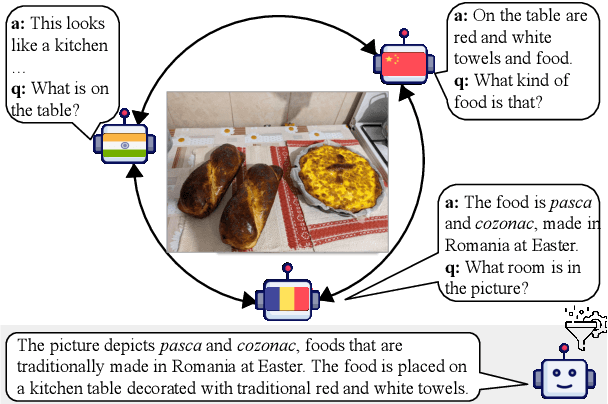
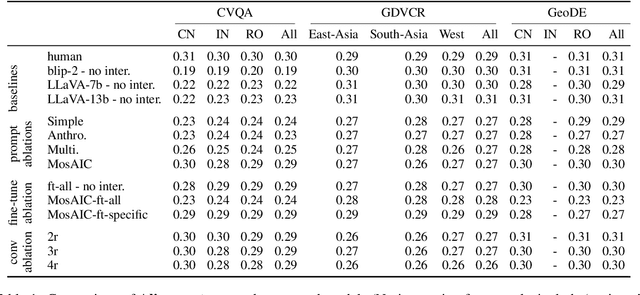
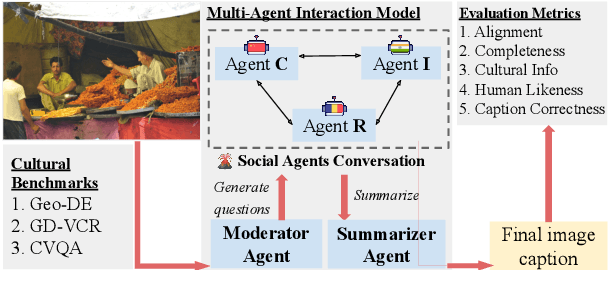
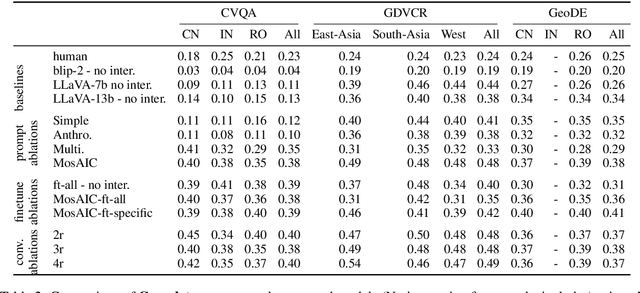
Abstract:Large Multimodal Models (LMMs) exhibit impressive performance across various multimodal tasks. However, their effectiveness in cross-cultural contexts remains limited due to the predominantly Western-centric nature of most data and models. Conversely, multi-agent models have shown significant capability in solving complex tasks. Our study evaluates the collective performance of LMMs in a multi-agent interaction setting for the novel task of cultural image captioning. Our contributions are as follows: (1) We introduce MosAIC, a Multi-Agent framework to enhance cross-cultural Image Captioning using LMMs with distinct cultural personas; (2) We provide a dataset of culturally enriched image captions in English for images from China, India, and Romania across three datasets: GeoDE, GD-VCR, CVQA; (3) We propose a culture-adaptable metric for evaluating cultural information within image captions; and (4) We show that the multi-agent interaction outperforms single-agent models across different metrics, and offer valuable insights for future research. Our dataset and models can be accessed at https://github.com/MichiganNLP/MosAIC.
Towards Implicit Bias Detection and Mitigation in Multi-Agent LLM Interactions
Oct 03, 2024Abstract:As Large Language Models (LLMs) continue to evolve, they are increasingly being employed in numerous studies to simulate societies and execute diverse social tasks. However, LLMs are susceptible to societal biases due to their exposure to human-generated data. Given that LLMs are being used to gain insights into various societal aspects, it is essential to mitigate these biases. To that end, our study investigates the presence of implicit gender biases in multi-agent LLM interactions and proposes two strategies to mitigate these biases. We begin by creating a dataset of scenarios where implicit gender biases might arise, and subsequently develop a metric to assess the presence of biases. Our empirical analysis reveals that LLMs generate outputs characterized by strong implicit bias associations (>= 50\% of the time). Furthermore, these biases tend to escalate following multi-agent interactions. To mitigate them, we propose two strategies: self-reflection with in-context examples (ICE); and supervised fine-tuning. Our research demonstrates that both methods effectively mitigate implicit biases, with the ensemble of fine-tuning and self-reflection proving to be the most successful.
Application Specific Compression of Deep Learning Models
Sep 09, 2024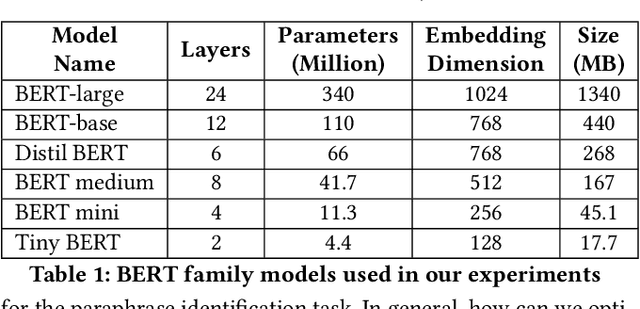
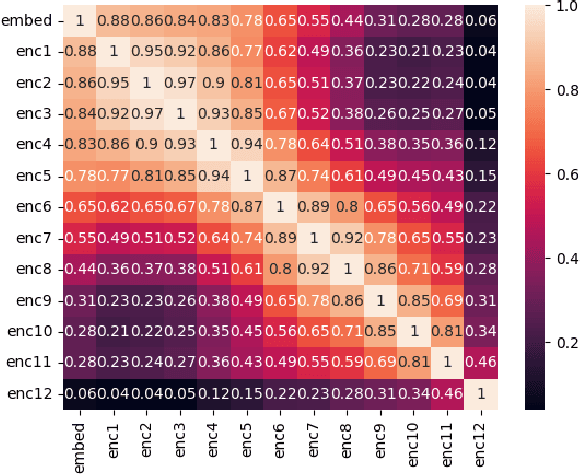
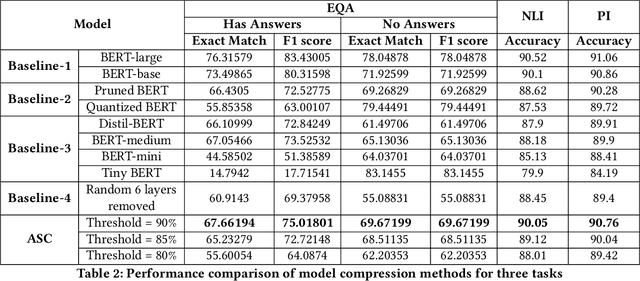
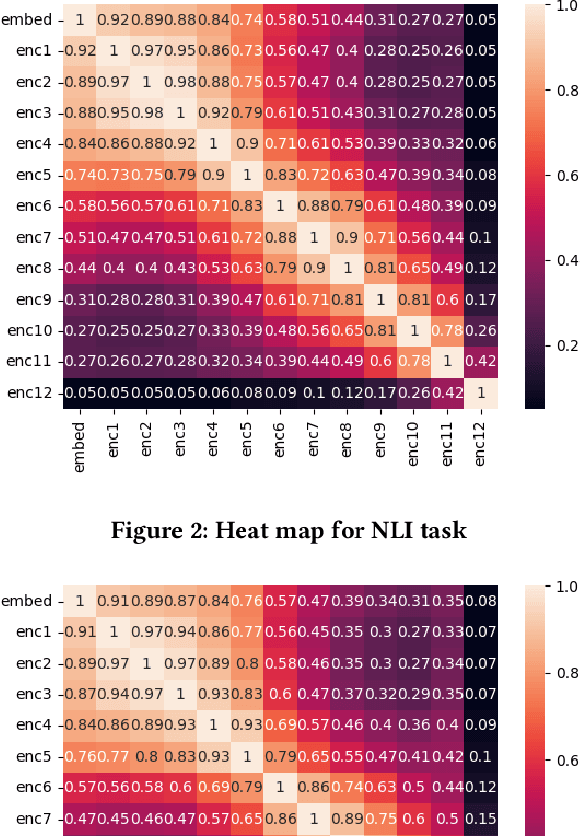
Abstract:Large Deep Learning models are compressed and deployed for specific applications. However, current Deep Learning model compression methods do not utilize the information about the target application. As a result, the compressed models are application agnostic. Our goal is to customize the model compression process to create a compressed model that will perform better for the target application. Our method, Application Specific Compression (ASC), identifies and prunes components of the large Deep Learning model that are redundant specifically for the given target application. The intuition of our work is to prune the parts of the network that do not contribute significantly to updating the data representation for the given application. We have experimented with the BERT family of models for three applications: Extractive QA, Natural Language Inference, and Paraphrase Identification. We observe that customized compressed models created using ASC method perform better than existing model compression methods and off-the-shelf compressed models.
Towards Region-aware Bias Evaluation Metrics
Jun 23, 2024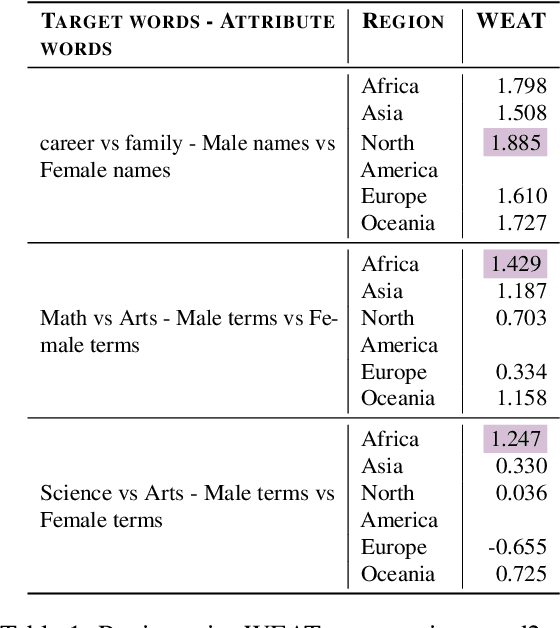


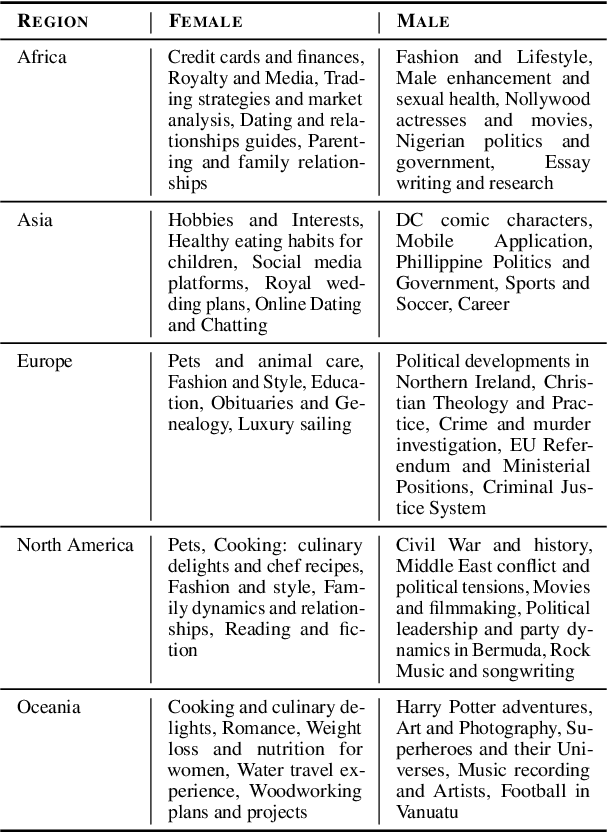
Abstract:When exposed to human-generated data, language models are known to learn and amplify societal biases. While previous works introduced benchmarks that can be used to assess the bias in these models, they rely on assumptions that may not be universally true. For instance, a gender bias dimension commonly used by these metrics is that of family--career, but this may not be the only common bias in certain regions of the world. In this paper, we identify topical differences in gender bias across different regions and propose a region-aware bottom-up approach for bias assessment. Our proposed approach uses gender-aligned topics for a given region and identifies gender bias dimensions in the form of topic pairs that are likely to capture gender societal biases. Several of our proposed bias topic pairs are on par with human perception of gender biases in these regions in comparison to the existing ones, and we also identify new pairs that are more aligned than the existing ones. In addition, we use our region-aware bias topic pairs in a Word Embedding Association Test (WEAT)-based evaluation metric to test for gender biases across different regions in different data domains. We also find that LLMs have a higher alignment to bias pairs for highly-represented regions showing the importance of region-aware bias evaluation metric.
Measuring Spurious Correlation in Classification: 'Clever Hans' in Translationese
Aug 25, 2023



Abstract:Recent work has shown evidence of 'Clever Hans' behavior in high-performance neural translationese classifiers, where BERT-based classifiers capitalize on spurious correlations, in particular topic information, between data and target classification labels, rather than genuine translationese signals. Translationese signals are subtle (especially for professional translation) and compete with many other signals in the data such as genre, style, author, and, in particular, topic. This raises the general question of how much of the performance of a classifier is really due to spurious correlations in the data versus the signals actually targeted for by the classifier, especially for subtle target signals and in challenging (low resource) data settings. We focus on topic-based spurious correlation and approach the question from two directions: (i) where we have no knowledge about spurious topic information and its distribution in the data, (ii) where we have some indication about the nature of spurious topic correlations. For (i) we develop a measure from first principles capturing alignment of unsupervised topics with target classification labels as an indication of spurious topic information in the data. We show that our measure is the same as purity in clustering and propose a 'topic floor' (as in a 'noise floor') for classification. For (ii) we investigate masking of known spurious topic carriers in classification. Both (i) and (ii) contribute to quantifying and (ii) to mitigating spurious correlations.
Are Word Embedding Methods Stable and Should We Care About It?
Apr 17, 2021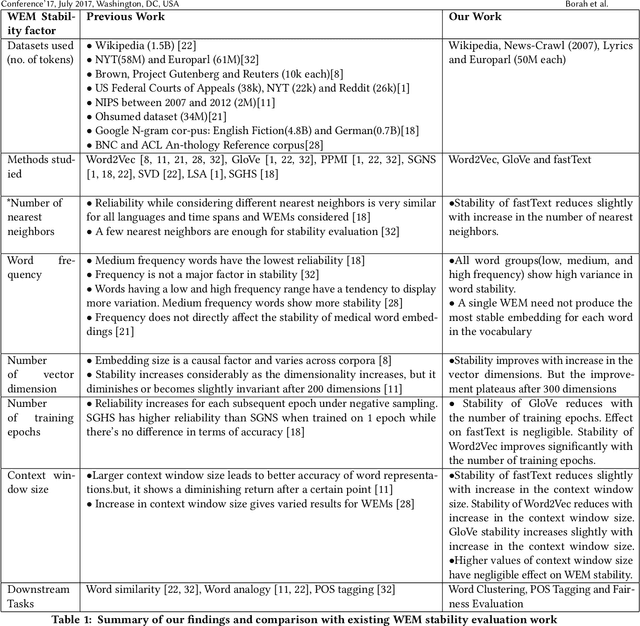
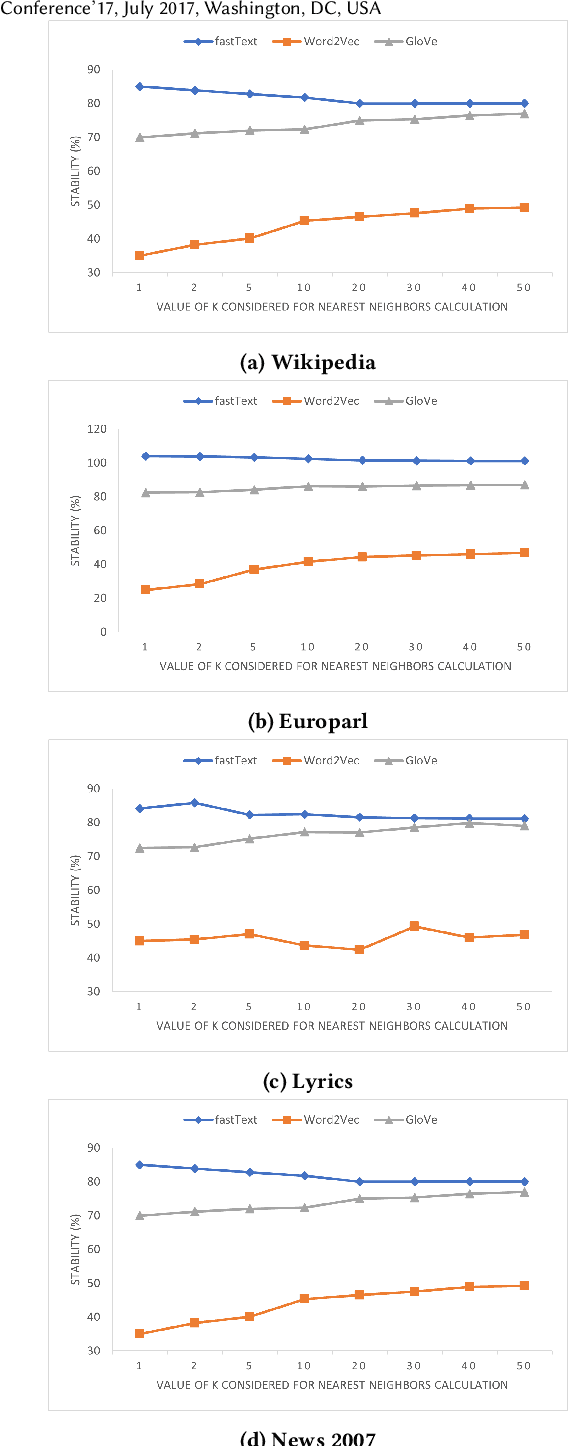

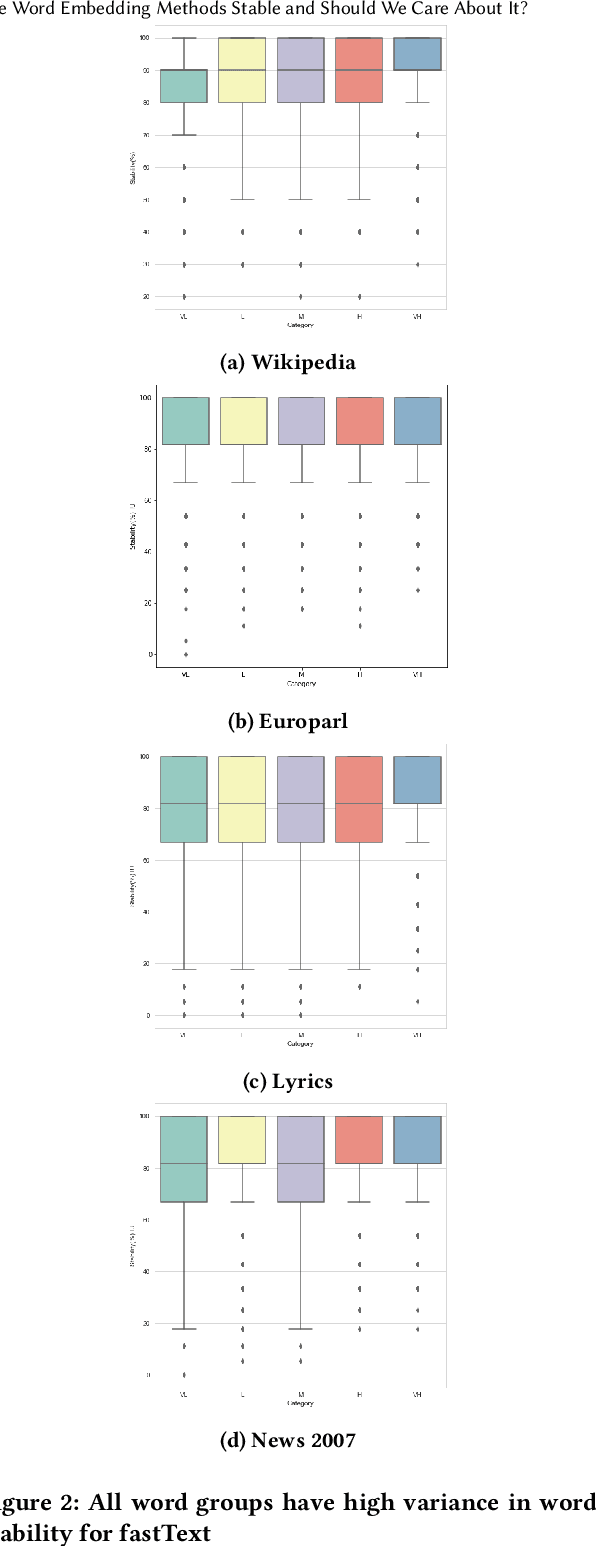
Abstract:A representation learning method is considered stable if it consistently generates similar representation of the given data across multiple runs. Word Embedding Methods (WEMs) are a class of representation learning methods that generate dense vector representation for each word in the given text data. The central idea of this paper is to explore the stability measurement of WEMs using intrinsic evaluation based on word similarity. We experiment with three popular WEMs: Word2Vec, GloVe, and fastText. For stability measurement, we investigate the effect of five parameters involved in training these models. We perform experiments using four real-world datasets from different domains: Wikipedia, News, Song lyrics, and European parliament proceedings. We also observe the effect of WEM stability on three downstream tasks: Clustering, POS tagging, and Fairness evaluation. Our experiments indicate that amongst the three WEMs, fastText is the most stable, followed by GloVe and Word2Vec.
 Add to Chrome
Add to Chrome Add to Firefox
Add to Firefox Add to Edge
Add to Edge